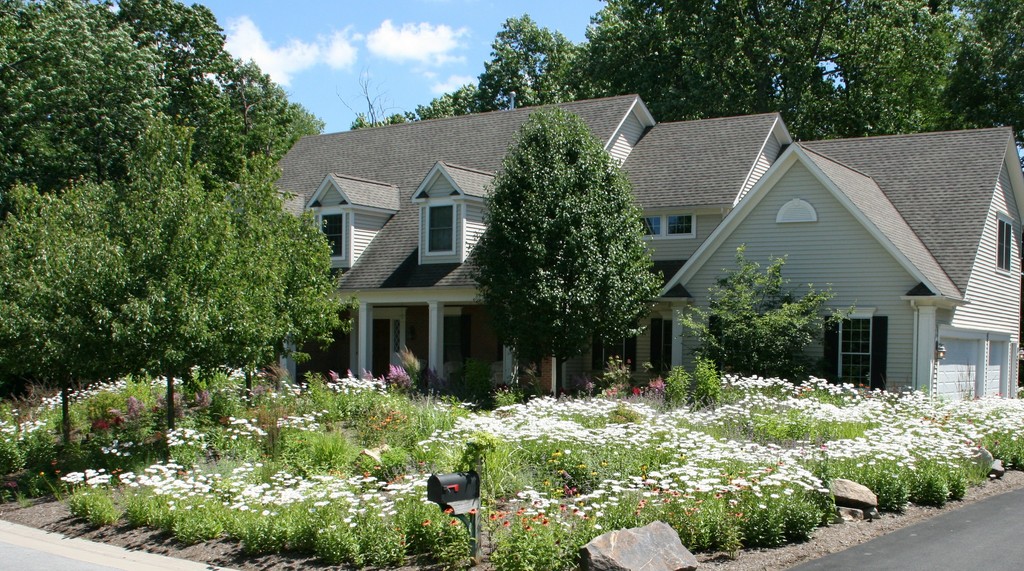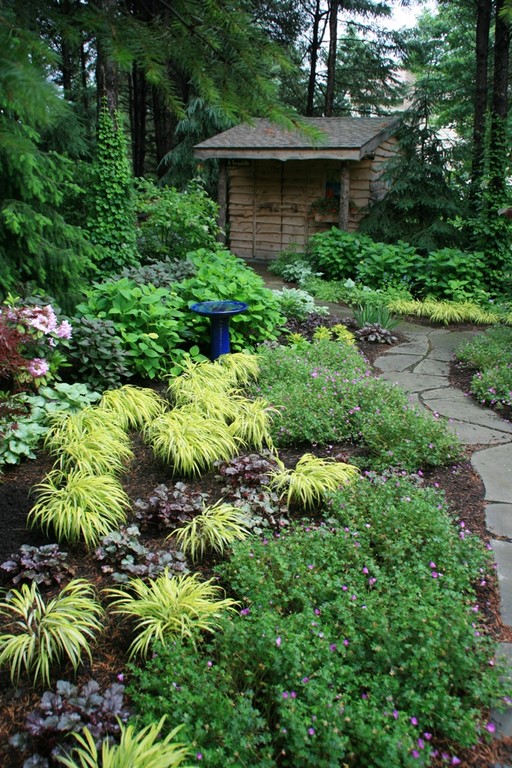Down to the Ground

Whether you’re a watershaper or a landscape architect, designer or artist, I’ve always felt that those of us who work on exterior environments should stand on the front lines of the “green movement.” After all, we move the soil, alter the terrain, plant trees and shrubs and define the use of water, among many other things.
In the course of doing what we do, in other words, we alter (sometimes profoundly) the environments in which our clients live and work. It seems the media are taking notice.
Every year, for example, our local Rochester Business Journal conducts a competition called the Environmental Leadership Awards, a program that recognizes companies in the area that develop and implement ideas that help sustain the environment in our slice of New York. For the most part, awards go to big companies that have established extensive recycling programs, and I’ve always seen the awards not only as a good marketing opportunity, but also as a measure of the degree to which companies shape the environment with their business practices.
We’ve entered before without winning, so we took a slightly different tack this year, starting with an extensive list of the things we do that have an obviously positive effect on the environments we encounter. We were several pages into this exercise, touching on recycling, water conservation and a range of other points we knew were part of just about every application form.
At that point, we stopped and asked ourselves, “What do we really do that makes us green? What do we do that not only does no harm, but actually improves the planet? What do we as a company do that truly sets us apart from the competition?” In answering these questions, we discovered that the most positive things we do are not necessarily the sexiest but were truly the most significant.
IN THE DIRT
In past columns, for example, I’ve mentioned what we do to minimize energy consumption – putting high-efficiency watershape pumps on timers to avoid wasting energy when clients are at work or asleep, for example, or combining timers with photocells in our lighting control systems to reduce energy usage while also automatically adjusting daily on/off cycles.
Those are pretty obvious and are certainly not as sensational as what some local businesses have managed to do, such as putting giant wind turbines atop their buildings to generate electricity or establishing rooftop rain-harvesting gardens. As we see it, however, if you add up all of our smaller-scale contributions, it would be pretty close to even – and has certainly had positive effects on the bank accounts of our clients.
|
The Recycling Urge When we work on a site – any site – our goal is to recycle everything we have to remove. If we take out a concrete walkway, for example, we’ll do what we can to break it up and use it as fill or as backfill for retaining walls. Lately, however, we’re been having trouble meeting our recycling goal because we’re running into more and more sites where we’re taking out either pressure-treated wood and/or composite decking. Pressure-treated wood had its heyday in the 1980s and is now pushing past its useful lifespan. Trouble is, wood-recycling centers don’t want it, and it generally can’t be reused for anything on our job sites. The same is true with the first generation of composite decking: Even though it was touted as a lifetime product, the reality is that we’re now seeing sites where it needs to be replaced, either because of structural issues or changes in client attitudes about using “artificial” products. We recently removed just such a deck: The plastic recyclers didn’t want it because of its wood content, while the wood recyclers rejected it because of its plastic content. We thought we were stuck, but then we came up with a simple solution: We cut it up into manageable lengths and set it at the end of our facility’s driveway, where we sometimes leave leftover or recyclable bricks and pavers. Within a day or two, every scrap was gone – and now we place all materials we can’t use ourselves on the street for discerning recyclers! B.Z. |
But then we came to what seemed to all of us to be the least sexy of all our possible contributions to the environment: that is, soil preparation for planting. We’ve always approached this function as being just as important as preparation of a proper foundation for a home, patio or retaining wall – another one in a long list of key project details that are never seen again by our clients once we’re done.
Through the years, I’ve seen the shortcuts and missteps others have taken – plants stuck in solid clay, pushed through sheets of plywood left along foundations, plopped into gravel on the margins of paving installations and even punched through sections of concrete left over from masonry projects. When you consider the added work needed to keep these plants alive (all that extra watering, fertilizing and pruning) or the work involved in replacing them when they die – how “green” is that?
We plant trees and plants to help with carbon/oxygen exchange and cool the planet by minimizing the urban “heat island” effect, but how much good are we really doing when we end up having to drive big diesel trucks back a site to deal with failing plants and using potable water in ill-fated efforts to keep them alive? Basically, I think we all need to do a better job from the start by giving these plants and trees a fighting chance at survival.
What we do as a company is take an extreme approach to soil preparation on every site we plant. In some cases, we’ll begin by testing the soil, although in most instances, the existing vegetation tells us what we need to know.
If there’s lawn to be removed, we do it through the careful use of Roundup. While using an herbicide does not seem on the surface to be the environmentally sound thing to do, removing the grass with a sod cutter is even more problematic in my opinion. (Moreover, we’re quite careful in applying Roundup, using a three-foot-wide roller rather than a spray system so the material goes fairly precisely where we want it to go.)
As a fallback in cases where clients object to using the herbicide, we have them spread sheets of black plastic to kill the grass: All it takes is a couple sunny days for a lawn to become a memory – although for large areas, this approach is definitely a chore.
DIGGING IN
Once the grass is dead, we rototill the area to a depth of about twelve inches, then add a three-inch-thick layer of compost before rototilling again.
There are many advantages to this approach, the most obvious being that we markedly improve the quality of the soil for the plants we’ll be inserting. There’s also the fact that the labor involved in installing those plants is significantly less because we’ve turned the entire area into one big, fluffy planter. This saves fuel use with (and pollution from) our vehicles, especially when we pare a day or two off of our time on site.
| All of the perennials seen at left and below were planted as one-gallon containers. Extensive site preparation is responsible for their remarkable growth: The photograph on the left was taken three years after planting, while the one to the right was taken just a year after planting. |
We place our plants using a michorrizhal bacteria called M-Roots to give root systems a head start in assimilating to their new environment. Altogether and with proper watering, we’ve found that, by using this approach, we lose precious few plants overall.
 I contrast this experience with the one I had in working for a large landscape company on Long Island many years ago: I ran a crew of four doing nothing but replacing dead plants on projects – six days a week, straight through the summer. I shudder to think of how much money the company could have saved – even beyond the fuel use and pollution costs – if the planting crews had used proper techniques in the first place!
I contrast this experience with the one I had in working for a large landscape company on Long Island many years ago: I ran a crew of four doing nothing but replacing dead plants on projects – six days a week, straight through the summer. I shudder to think of how much money the company could have saved – even beyond the fuel use and pollution costs – if the planting crews had used proper techniques in the first place!
And because of the way we do things now, we can be very stingy in water use. In fact, when watering systems are needed, I do my best to convince my clients to have us install simple drip lines rather than sprinklers. I tell them that, with proper soil preparation, plants only need regular watering for the first season or two and then should on their own in using rainfall to supply their needs. After the first or second season, the watering system should be turned off!
(I believe this is true no matter where you live and work – if, of course, you’re attuned enough to what’s going on that you’re using plants fully adapted to your local environment, whether you’re in the deserts of the great southwest or experience the chills of a northern-tier state.)
Where we can, we also encourage the use of rain barrels and rainwater-retention systems for use in plant maintenance. While this is a novel concept and therefore something of an uphill battle with clients, we try on every project to convince them to go this way, letting them know that, at my own home, just two rain barrels provide all the water I need to take care of all my container plants and newly installed shrubs and perennials.
This approach might not work on a large property, but even then we discuss the fact that water is not a renewable resource – and with increasing frequency we’re able to design water-reclamation systems that take care of entire landscapes. (If you need to know more, I suggest taking a look at Sustainable Land Development, a trade publication that offers in-depth information and access to suppliers.)
Both of these non-sexy measures – proper soil preparation and judicious water use – can result in huge benefits for our clients and our planet. The days of digging holes, throwing in some peat moss, cramming in a plant and watering it to the point of drowning it should be over: If we want to be responsible caretakers of the environment, we need to use proper installation and watering techniques every time.
MAKING OUR CASE
Although soil preparation and water conservation are not the most compelling of all subjects covered by WaterShapes (particularly relative to the amazing pools, fountains, ponds, streams and waterfeatures that are steadily featured), we as watershapers, landscape experts and engineers should focus on setting examples for others to follow: Our work directly effects the planet, and doing so responsibly is something we should all take seriously.
|
All Wet How many of us company owners have made a practice of going to a local big box store every week to stock up on cases of bottled water for our work crews? I know I did, and for a long time. But then I saw photographs of the infamous Pacific Ocean “toilet bowl,” an area larger than the state of Texas in which billions of plastic bottle and six-pack rings (and more floating plastic debris) swirl in a circle, caught amid the ocean’s currents. I’ve also seen photos of marine life growing up with rings wrapped around their bodies and caught in their beaks. The last straw: Photos of the Citarum River in Indonesia, where for as far as the eye can see there is nothing more than a carpet of plastic bottles and bags. On the spot, we stopped buying bottled water, opting instead to give each crew a large cooler we fill with filtered water as well as reusable bottles they have on site. And for those on our crews who still purchase bottled water and other drinks on their own, we’ve set up bins in our shop, strongly suggest their use and send a monthly load to our local recycling center. B.Z. |
In that spirit, we completed our application for Rochester’s Environmental Leadership Awards and submitted it along with about 20 pages of information on our humble ten-person landscape operation. Not only did we explain our recycling program, but also our use of water-saving design and installation methods, our design of landscapes that avoided use of extensive lawn areas and much more, including testimonials from clients and colleagues.
In years past, we had entered this competition only to see the largest companies take all the prizes, but this year was different: Indeed, two companies with ten or fewer employees were honored along with local corporations – and ours was one of them.
We were thrilled at the thought of being recognized for something we care deeply about, but we were even more excited about the actual award, which was a painting done by one of our local dignitaries: an elephant at the Seneca Park Zoo!
Bruce Zaretsky is president of Zaretsky and Associates, a landscape design/construction/consultation company in Rochester, N.Y. Nationally recognized for creative and inspiring residential landscapes, he also works with healthcare facilities, nursing homes and local municipalities in conceiving and installing healing and meditation gardens. You can reach him at bruce@zaretskyassociates.com.











